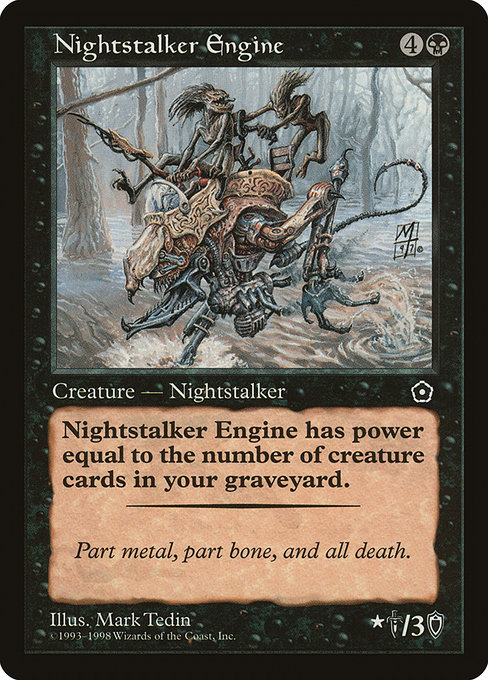
Image courtesy of Scryfall.com
Illustration at the crossroads: traditional vs digital in MTG
Magic: The Gathering has always been a conversation between the painter’s brush and the designer’s palette. Early sets leaned on analog mastery—oil, acrylic, and airbrush, applying a tactile sense of weight to creatures that inhabited our favorite worlds. As the hobby matured, digital tools offered new frontiers: glow effects, intricate textures, and the ability to iterate on a piece with the click of a mouse. The Nightstalker Engine, a rare from Portal Second Age’s starter-era lineup, sits comfortably in that transitional zone. Its image, created in a time when card art was still largely the realm of traditional media, now benefits from the digital restoration and high-resolution scans that let fans study brushwork, lighting, and composition in startling detail 🧙♂️🔥💎⚔️🎨.
A quick tour of the card’s frame and flavor
From the very first glance at Nightstalker Engine, you’re met with a creature that feels both ominous and purposeful. The mana cost is {4}{B}, situating the card firmly in black mana’s wheelhouse: resourceful, patient, and sinister when the moment calls for it. Its power is not a static number but rather a dynamic measure—the power equals the number of creature cards in your graveyard. That simple line ties the art to the game’s core mechanics: the more you fill your graveyard with your own beings, the more terrifying Nightstalker Engine becomes. The flavor text—“Part metal, part bone, and all death.”—reads like a manifesto for a design that revels in graveyard synergy and late-game inevitability 🧙♂️, reminding players that the art isn’t just decoration; it’s a narrative catalyst.
Traditional touchstones in the piece
Look closely at the traditional-era prints that inspired this illustration. Mark Tedin’s line work carries the weight of time; you can sense the careful layering of pigment that would have been common in the late 1990s. The piece seems to balance stark geometry—gears, cogs, and a chassis of dark metal—with organic, almost bone-like curves, which captures the flavor of a night-bound engine that is as much necromantic construct as it is machine. In a world before modern post-processing, such pieces depended on the artist’s ability to convey texture and mood with limited color palettes and varied brush density. The result is a grounded, tactile artifact: something you could imagine wielding in a game as a real object, not just a card on a table 🧙♂️🔥.
Digital evolution: subtle shifts in a familiar face
Fast-forward to today, and digital techniques give us a different lens for the same concept. The Nightstalker Engine’s later scans and reprints show tactile weathering: micro-scratches on metal, a spectral glow spilling from runes, and a depth that comes from layered shading. These are the kinds of improvements digital workflows enable without changing the core composition or that iconic silhouette. The creature’s stance—pensive, with gears turning like a silent heartbeat—reads clearly at any scale, from a tiny card to a large poster. It’s a reminder that digital tools can preserve the mood of a traditional painting while enhancing the viewer’s ability to study the piece in close detail, which is a boon for collectors and lore-hungry players alike 🧙♂️🎨.
What the art communicates about the card’s playstyle
Visual storytelling and gameplay mechanics often intersect in MTG more than players admit. Nightstalker Engine thrives on your graveyard, so the art’s nocturnal palette—a stormy mix of onyx, slate, and suggestion of ghostly blue glow—echoes the black color identity’s themes: reclamation, inevitability, and the slow, menacing build toward a lethal inevitability. The art invites a narrative of a workshop where death is engineered into a weapon, which neatly aligns with a strategy that grows more dangerous as your graveyard fills. In casual games or casual-competitive formats, that thematic alignment matters just as much as the numbers on the card 🔥🧙♂️.
Choosing between traditional and digital prints for your collection
If you’re a collector chasing the tactile joy of a hand-painted original, you’re drawn to the aura of the era—the subtle brushstrokes, the painter’s intent preserved in a scanned capture, and the whispers of provenance that come with a Mark Tedin signature on a Portal print. On the other hand, digital-era reconstructions and high-resolution scans offer pristine detail, faithful color reproduction, and the ability to admire the piece in ultra-fine clarity online or on a large monitor. Either path enhances the reverence for a card that sits, even now, at the intersection of nostalgia and ongoing strategy in black-dominated decks 🧙♂️💎.
Beyond the frame: designing a play space that honors the art
For many players, the art is not only decoration; it’s a creative compass. The stark, mechanical menace of Nightstalker Engine can inspire themed decks: black-heavy strategies that lean into graveyard interactions, control elements, and late-game finisher lines. It’s a card that invites you to brainstorm not just how to win, but how to tell a story on the battlefield. If you’re setting up a desk or play area that honors MTG artistry—from the painter’s palette to the pixel—consider curating pieces that echo the transition from brushstroke to bitmap. A properly arranged space can become a mini-gallery where each card teaches you something about how art and mechanics entwine in Magic 🧙♂️🎲.
Product tie-in: a desk side upgrade for fans
While you study the layered textures of Nightstalker Engine, you might also be upgrading your gaming setup. A purpose-built mouse pad can keep your focus sharp and your wrists comfortable as you assemble decks and draft with friends. If you’re in the market for a new surface, check out a practical, high-quality option at the product link below. It blends well with the atmosphere of a black mana-heavy board and serves as a subtle nod to the tactile pleasure of physical play while you admire the art that inspired it 🧙♂️🔥💎.